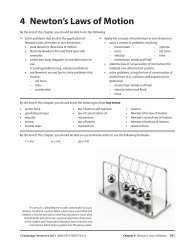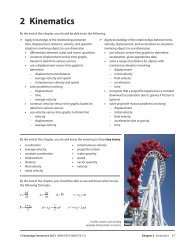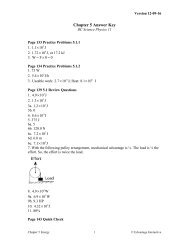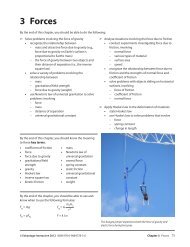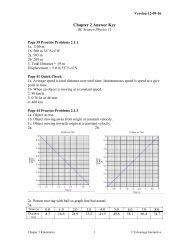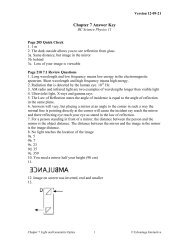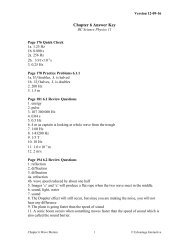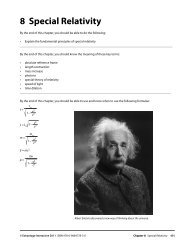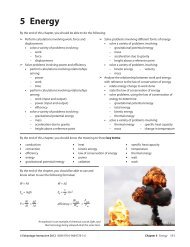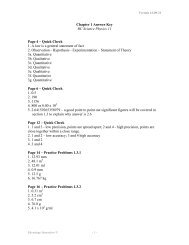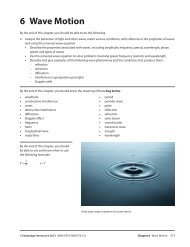1 Skills, Methods, and the Nature of Physics - BC Science Physics 11
1 Skills, Methods, and the Nature of Physics - BC Science Physics 11
1 Skills, Methods, and the Nature of Physics - BC Science Physics 11
You also want an ePaper? Increase the reach of your titles
YUMPU automatically turns print PDFs into web optimized ePapers that Google loves.
Investigation 1-4 Making a Pendulum Clock<br />
Purpose<br />
To learn how a pendulum can be used as a clock<br />
Procedure<br />
1. Prepare a simple pendulum by tying a string to a pendulum bob, ei<strong>the</strong>r a large washer, as in Figure 1.4.6, or<br />
a drilled metal ball. Feed <strong>the</strong> string through <strong>the</strong> opening <strong>of</strong> <strong>the</strong> pendulum support. Avoid winding <strong>the</strong> string<br />
around <strong>the</strong> support rod. If you do this, <strong>the</strong> length <strong>of</strong> <strong>the</strong> pendulum changes during a swing.<br />
����<br />
�������<br />
�����������<br />
����������<br />
Figure 1.4.6 Setup for Investigation 1-4<br />
����������<br />
�<br />
2. Start by adjusting <strong>the</strong> length l <strong>of</strong> <strong>the</strong> pendulum so that it is as close to being 10.00 cm as you can make it.<br />
Measure l from <strong>the</strong> bottom <strong>of</strong> <strong>the</strong> pendulum clamp to <strong>the</strong> centre <strong>of</strong> <strong>the</strong> bob, as shown in Figure 1.4.6.<br />
3. Push <strong>the</strong> bob a small distance, about 2 cm, to one side <strong>and</strong> let it swing freely. To get a rough idea <strong>of</strong> how long<br />
<strong>the</strong> pendulum takes to make one swing, use a stopwatch to measure <strong>the</strong> time it takes for <strong>the</strong> bob to swing<br />
from <strong>the</strong> highest point on one side <strong>of</strong> <strong>the</strong> swing to <strong>the</strong> highest point on <strong>the</strong> o<strong>the</strong>r side, <strong>the</strong>n back to its starting<br />
position. The time it takes <strong>the</strong> pendulum bob to complete a full swing like this is called <strong>the</strong> period (T) <strong>of</strong> <strong>the</strong><br />
pendulum. Try measuring <strong>the</strong> period <strong>of</strong> one swing several times with your stopwatch. Why do you think your<br />
measurements are so inconsistent?<br />
4. To obtain a more reliable measurement <strong>of</strong> <strong>the</strong> period <strong>of</strong> <strong>the</strong> pendulum, you will now measure <strong>the</strong> time for<br />
a large number <strong>of</strong> swings (50) <strong>and</strong> find <strong>the</strong> average time for one swing by dividing by 50. Set your 10.00 cm<br />
pendulum swinging through a small arc, as before. Start counting backward (3, 2, 1, 0, 1, 2, 3, 4, etc.) <strong>and</strong> start<br />
your stopwatch at 0. Stop your watch after 50 swings <strong>and</strong> record <strong>the</strong> time your pendulum took to complete<br />
50 swings.<br />
5. To figure out <strong>the</strong> period <strong>of</strong> <strong>the</strong> pendulum, divide <strong>the</strong> time for 50 swings by 50.0. Record <strong>the</strong> period, T, in a table<br />
like Table 1.4.3. Check your result by repeating <strong>the</strong> measurement. If necessary, repeat a third time.<br />
© Edvantage Interactive 2012 ISBN 978-0-9864778-3-6 Chapter 1 <strong>Skills</strong>, <strong>Methods</strong>, <strong>and</strong> <strong>the</strong> <strong>Nature</strong> <strong>of</strong> <strong>Physics</strong> 31



